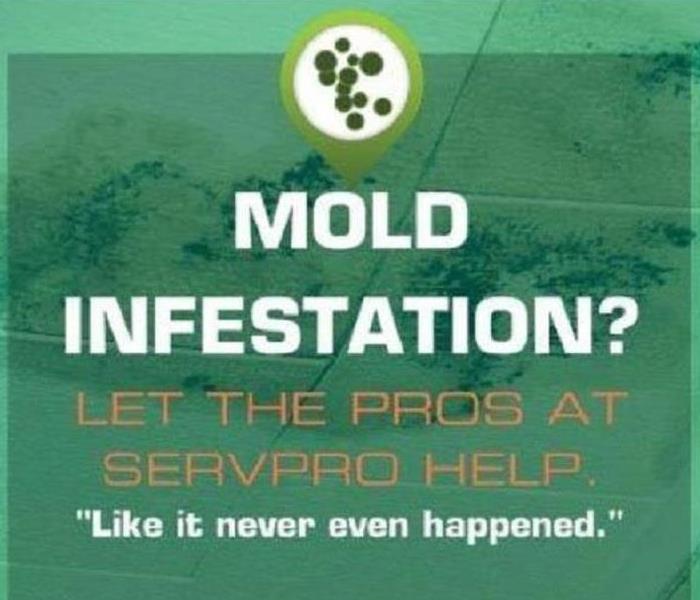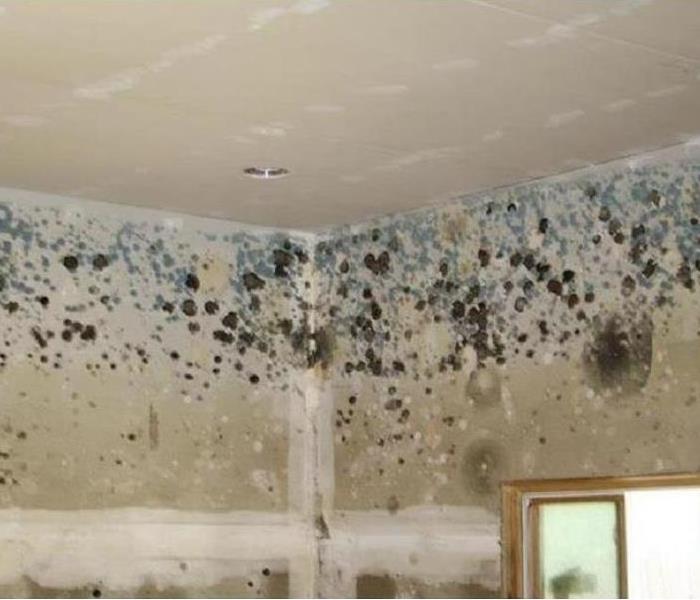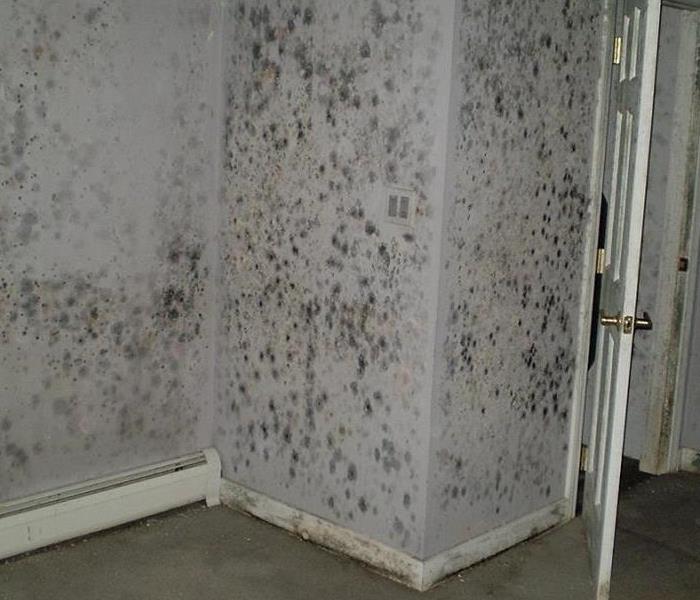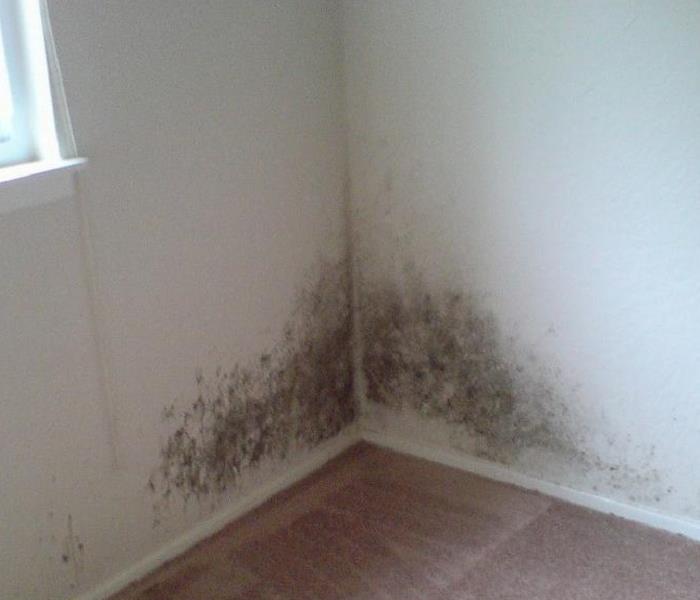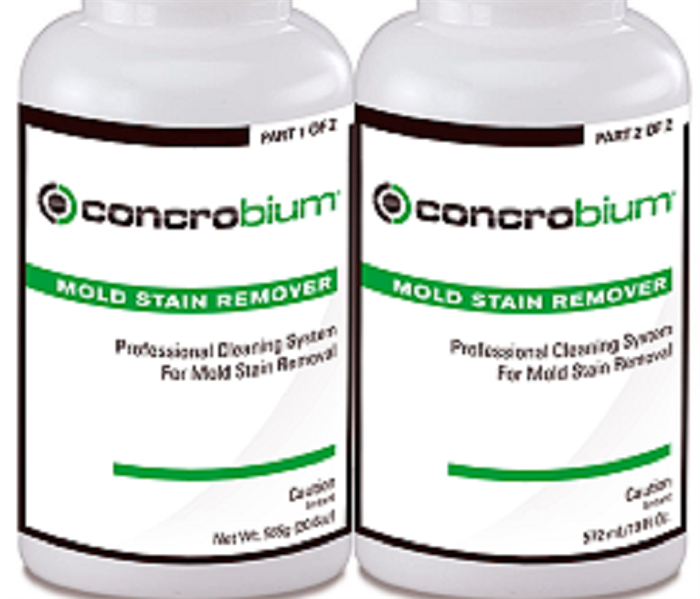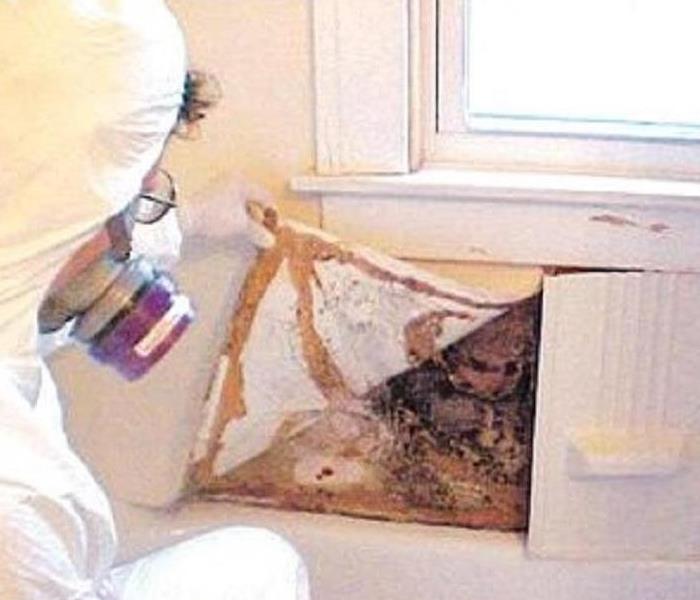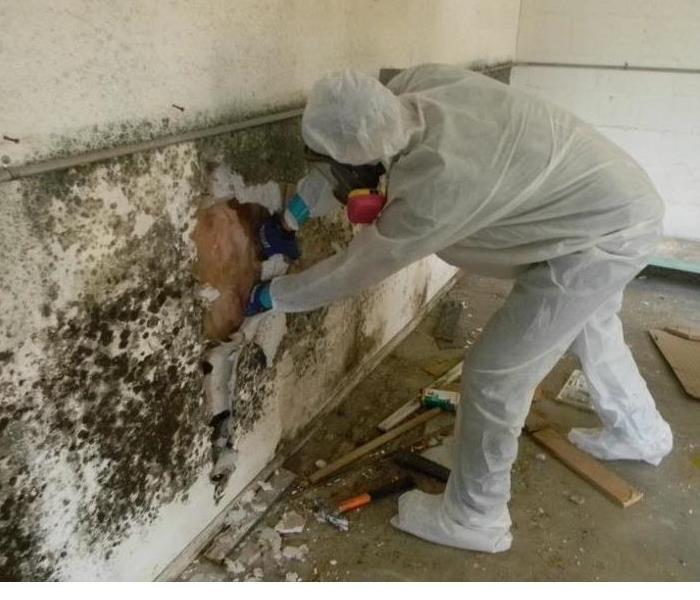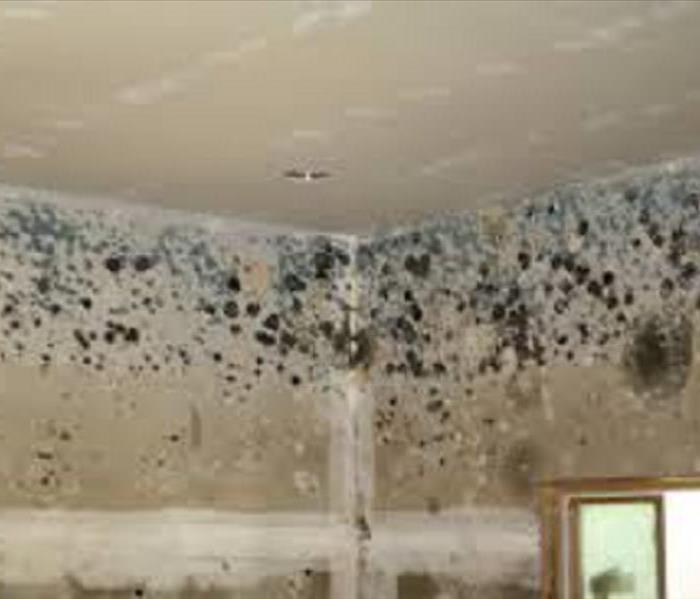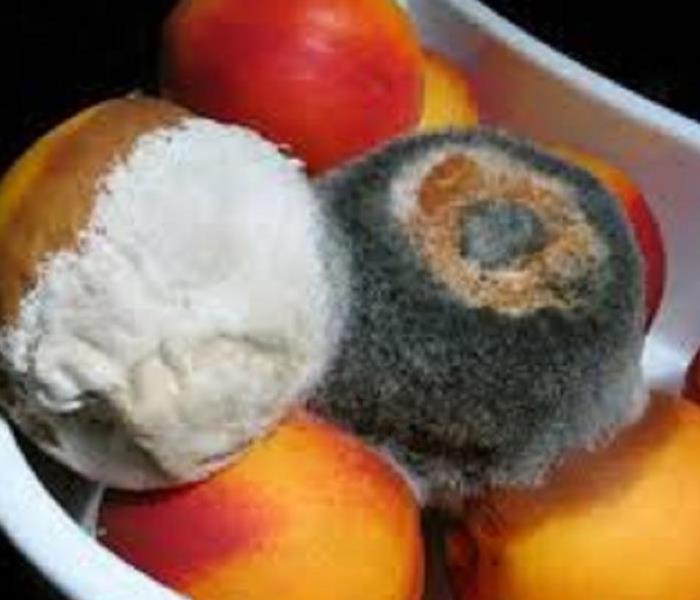Recent Mold Remediation Posts
Mold remediation-What is it?
8/1/2018 (Permalink)
People often ask the question, what is mold remediation? Those who do not work in the mold industry may not know what mold remediation is or the procedures needed to properly get rid of mold.
It is first important to know that mold spores exist naturally just about everywhere. If you have an industrial hygienist come to your property to complete mold testing, they will test the air outside and in different areas inside your property. When the hygienist performs testing, they are looking to see what the spore count is in certain areas and what types of mold are present. Based on the testing, it can be determined what exactly needs to be done in order to remediate the mold in your home or business.
When performing remediation, it is important to follow proper procedures. First, you want to make sure the underlying problem causing the mold growth has been stopped. If your property has a moisture problem, you can remove the areas of mold that are currently present. However, the mold will continue to grow and further remediation will be necessary.
The affected area should be contained. Often to contain an affected area we set up a plastic containment barrier specially created to keep mold spores from exiting the affected area. Containment barriers should be set up around any openings in the room such as closets, hallways and doorways that lead to unaffected areas. Vents should be covered so that the spores to not get into your duct system.
Proper air filtration is necessary. SERVPRO uses air scrubbers to filter the spores out of the air while work is being completed. This step is important because while contaminated materials are being removed or cleaned, mold spores are being thrown into the air. The air scrubbers draw air in from the nearby surroundings and pass it through filters to remove contaminants.
What type of materials the mold is growing on determines the methods taken to remediate the mold. Some of the methods used for remediation are:
- Removal of the material
- Dry ice blasting
- Mold stain remover
- Mechanical steel grinding
Should you have any questions regarding mold, please call our office at 315-457-3432.
Defense Against Mold Growth
7/25/2018 (Permalink)
It is important to start mitigation as soon as a water damage happens to avoid mold growth. Mold can start to become visible in as little as 24-48 hours depending on the conditions. Many times, water damages are not found immediately which makes it vital to respond to water damage as soon as it is found. Mold can be harmful to you and your loved ones, as well as, the building structure. Somethings you can do to fight mold growth:
- Keep the humidity between 30-60 percent
- Provide proper drainage away from the building structure
- Inspect plumbing and appliances regularly
- Keep gutters and drains free from debris
- Inspect windows, doorways, roofs and other areas where water may enter
- Don't leave it, respond to all water intrusions immediately
- Call us if you experience water damage!
Black Mold
7/2/2018 (Permalink)
At SERVPRO of North Onondaga County, we often get calls from customers with questions or concerns regarding black mold. People worry about how harmful black mold is to their health, how to get rid of it, and how to stop the mold from coming back. In this blog post we will try to create a quick reference on the subject of black mold.
The scientific name for black mold is Stachybotrys Chartarum or Stachybotrys Atra. Black mold usually grows in moist areas with poor circulation. Mold often produces a strong odor. There are many types of mold which have a similar appearance to black mold. An industrial hygienist would be able to identify whether or not the mold you have in your home is black mold or another type.
Mold affects everyone differently. The American Industrial Hygiene Association advise that pregnant women, infants and children, the elderly and the immunocompromised, those with allergies, asthma or respiratory conditions are at risk to more severe side effects than others.
If you suspect that black mold is in your home there are a few steps needed to correctly get rid of the mold and keep it from coming back. First, you need to figure out where the mold is in your home. You may need to call an Industrial Hygienist to complete an assessment of your home. The hygienist will complete a moisture intrusion assessment, air and surface sampling and relative humidity testing. This investigation will determine what kind, how much and where the mold is present in your home. From knowing these items, you will be able to figure out what is causing the mold to grow and what area of your home mold remediation is necessary. It is important to fix the problem that is causing the mold to grow. For example, if there is a leaky pipe dripping into an area causing mold to grow, the pipe should be fixed before mold remediation takes place. Next, you will need to remediate the mold. By disrupting the materials that mold is growing on, you can easily spread mold spores into the air multiplying the spores rather than reducing them. It is important to contact a company who specializes in mold remediation to get mold levels back to normal. At SERVPRO of North Onondaga County our technicians have are highly trained mold remediation specialists. Our technicians have Applied Microbial Remediation Certifications and have completed the New York State Mold Abatement Worker Course.
Mold vs. Bacteria
6/18/2018 (Permalink)
While mold and bacteria are often grouped together, they are actually two very different organisms. Both occur naturally in nature but certain types of molds and bacteria may be harmful to humans.Size. Molds are typically a lot larger than bacteria and possess hyphae or long, multi-celled filaments. Bacteria are generally smaller and more numerous in size but less complex.
Cellular structure. Molds are fungi and bacteria are not. Fungi are considered eukaryotes which means their DNA is enclosed in a nucleus (often referred to as a proper or well-defined nucleus) which is separated from their cytoplasm. The nucleus of a bacteria cell is not separated from their cytoplasm making them prokaryotes. What makes fungi cells complex are all the structures within their cell that bacteria cells do no possess.
Growth. There are two types of fungi which are important to consider when talking about growth; filamentous and yeasts. Fungal yeast reproduce by budding and filamentous fungi reproduce by branching or elongation. Bacteria on the other hand, regenerate by binary fission which means each parent cell divides into two smaller cells, typically of similar sizes.
Food and nutrition. Bacteria are autotrophic in that they have the ability to produce their own food via light or chemical energy and they are heterotrophic as well meaning, they can take in energy from other organisms for food if need be. Fungi are a type of heterotroph called saprophytes which get their energy from dead organic matter. This is why fungi are often found in soil or on surfaces that are in the process of decay.
Fungi and bacteria often come with a negative stigma but don’t forget about all the good they do! They release and create nutrients to provide energy for our ecosystem, are used in the fermentation of chemicals, the production of food and even in our bodies to make certain vitamins. Remember, not all molds and bacteria are created equally. While different, they are necessary to our ecosystems and way of life.
Mold Precautions
6/1/2018 (Permalink)
SERVPRO Professionals handle water damages everyday and know the prompt action required to prevent mold. Our Operations Manager has been with us for over 11 years and specializes in mold remediation. The following are common things to look for:
- Ongoing moisture problems which may be present. It's possible that a pipe has had a slow leak for sometime that has gone undetected.
- Watch for visible mold. Remember that not all mold will be visible to the eye.
- Strong musty odors
- Evidence for past moisture problems, look for water stains.
- Excessive humidity
All of these conditions may require the expertise of a qualified Indoor Air Quality/Environmental Professional to inspect for mold growth and water damage. If you have any questions regarding mold, please feel free to call our office and speak to someone. We can help point you in the correct direction of what steps you should take, we can send someone out to take a look at the possible mold and guide you.
Why Does Mold Form in Different Colors
5/16/2018 (Permalink)
After extensive research on the subject of the different colors of mold, this topic appears to be enigmatic. Scientists have come up with several different reasons why mold comes in such an array colors but can’t seem to nail down one over the other. There is a good chance a number of things are influencing the color of any give mold.Colors of mold for example, vary regionally. The colors in the Pacific Northwest tend to be more green and blue whereas oranges appear more often in the Amazon. Some molds secrete pigment known as melanin that can act as a barrier to protect them against other rival molds. Other studies indicate that the color of this particular fungi comes from its food source, genus, conditions under which it grows and it’s age. While all of these things do contribute in some way, shape or form, mycologists (scientists that study mold) still haven’t been able to pinpoint one single reason why this mysterious fungi comes in all colors of the rainbow to this day!
Concrobium Mold Stain Remover
4/2/2018 (Permalink)
SERVPRO has a large list of specialty branded products to clean a variety of different surfaces and materials. We do not sell these products to homeowners or commercial property owners, for the majority or our branded products, they are made for our employee use only. One of the products we have to remediate mold is our Concrobium® Mold Stain Remover. This product is an innovative mold stain remover designed to quickly and easily remove mold stains. Our concrobium physically separates mold from the surface to fully remediate the affected area. After the concrobium is sprayed on the affected area, we will allow the area to dry. Once dry, we will complete a thorough HEPA vacuuming to clean up any residual mold.
This product is safe to be used on most hard, non-porous or semi-porous surfaces. These surfaces include wood, composite wood, concrete, masonry, drywall, grout, fiberglass, tile, plastic laminate and metal. Concrobium Mold Stain Remover was made to remove cosmetic mold stains from surfaces.
If this product sounds like it would be helpful to remove mold stains in your home or property, please feel free to call our office. We can send out an estimator to look at the affected area and provide a detailed estimate on the cost of removal and the amount of time the project would take. From there, you can move forward to schedule to have our team provide remediation for you.
Avoiding Mold in Your Bathroom
4/2/2018 (Permalink)
Bathrooms are one of the most common areas of the home where mold occurs. Steamy showers with bad ventilation and possible leaks from the toilet, shower, tub or sink are the most common reasons for mold in the bathroom. However, you can prevent mold from occurring by watching out for these things:
- cracked or missing caulk- when caulk is cracked or missing, it allows water to get behind the wall or under flooring. When water pools and gets trapped, mold could begin to grow. You can prevent this from happening by recalling around the bathtub, sink or toilet.
- Bad or no ventilation- some bathrooms lack an exhaust fan allowing the steam from a hot shower to properly exit the bathroom. Without an exhaust fan, the steam causes the walls and flooring to dampen which could cause mold growth. Other times, the exhaust fan is not hooked up correctly or is for show rather than actually venting to the outside. A properly installed exhaust fan vents to the outside the remove the steam from the air.
- Broken seals- when seals around toilets or pipes break, they cause leaks that you likely can’t see because the leaks occur behind walls or under flooring.
Sometimes these leaks are are only found when flooring and walls are opened up and exposed.
Covering Up Mold
3/1/2018 (Permalink)
Over the years, we have talked to many home and business owners about mold. We have talked to people who have tried to get rid of the mold on their own and then decided that they need our help. You should know, we’re here for you! We’re here to answer your questions and remove the mold from your home safely and effectively.
We have talked to home owners who have sprayed mold, scrubbed the surface mold, painted over it with paint or Kilz. All of these techniques have ended with the same story, “the mold came back”.
The mold comes back because in these circumstances, your simply covering up the mold or removing what can be seen on the surface. These methods are not actually removing the mold completely from the materials where the mold has invaded.
Materials in your home that mold grows on can be very porous, therefore, even though you cant’t see if anymore doesn’t mean it doesn’t exist under the surface. Likewise, painting over the mold or spraying the mold covers it up for a limited time before the mold continues to grow and penetrates the new surface. Completely removing the mold will remove potential toxins from spreading and affecting the air you breathe.
When SERVPRO gets a call to remediate mold, we ensure that the job is done properly. We start out by containing the area where the mold exists. We HEPA vacuum all areas around where the mold exists. The HEPA vacuum is able to trap the smallest particles of mold. Following this step, we would continue with remediation specific to the affected materials where the mold exists. The whole time that remediation is occurring we run air scrubbers to continue to filter the spores out of the air.
Choosing a Mold Remediation Company You Can Trust
2/7/2018 (Permalink)
At SERVPRO, we get a lot of calls from people who are concerned about mold in their homes and businesses. Mold is something that causes a lot of worry as it should. Mold has the potential to cause many different kinds of health issues and can also cause a lot of structural damage. Please know that we're always happy to take your calls and emails to answer any questions that you have about mold.
If you're considering completing the mold remediation yourself, please know that there are many risks involved. It's important to choose a remediation company that has the proper equipment and knowledge to fully get rid of the mold. If mold remediation is not completed properly, you risk spreading the mold spores and affecting previously unaffected areas.
Things you should consider when choosing a mold remediation company are:
-Does the company understand mold and the potential hazards involved?
It's important that mold remediation is completely properly so that spores are not spread and all of the affected materials are removed and/or cleaned. At SERVPRO, our technicians have completed mold classes and have experienced on the job training.
-Do they recommend mold testing?
New York State requires that mold testing is completed before remediation can begin for most mold remediation work. Therefore, if a company is not completing mold testing they breaking the law. Mold testing allows the remediation specialists to identify the type of mold present which would determine exactly how the remediation is performed. Testing also identifies exactly where the mold is, as mold is not always identifiable to the human eye.
-Does the company keep records of what they are doing, daily notes, pictures of before, during and after?
This is important incase you ever need to go back and ask questions. Documentation is also helpful for insurance companies and if you ever want to sell your property you have specific details of what was done.
-Is the contaminated area properly contained?
This is important to stop the spores from spreading to unaffected areas.
-Is the remediation company insured?
Every SERVPRO franchise is required to be properly insured by our corporate office. Therefore, every SERVPRO is insured in order to be in business. We will gladly send any documentation needed to show what we are insured for.
-Do the technicians where protective gear?
All of our technicians understand the importance of wearing personal protective equipment to keep them safe while on the job.
-Does the remediation company discard the moldy materials?
Any company that completes mold remediation should properly bag the waste materials and remove them from your property so that you and your property are not exposed to the hazardous materials.
If there are any questions that you have, please feel free to call (315-457-3432 or email (SERVPRO5941@SERVPRO5941.com) us. We'll be happy to help!
Facts About Mold
2/7/2018 (Permalink)
When you have a water damage in your home, if not properly mitigated, you are at risk of mold becoming a problem. Today, I'm going to tell you some facts about mold:
- Mold is a type of fungus.
- One of the most common type of mold is known as mildew.
- There are hundreds of different types of mold.
- Mold can live indoors or outdoors and grows best in damp, warm, and humid environments.
- Even though bathrooms and basements are typically moist areas prone to the growth of molds, any moist area in the household may harbor mold.
- Having a properly installed fan in the bathroom can help reduce the moist content in the room.
- Running a dehumidifier in your basement, especially during the humid months, can help prevent mold from growing.
- Some people experience allergic reactions or have negative health side effects when exposed to mold. The likely hood of this depends on the type of mold growing and the person.
- Controlling the moisture content in your home is the best way to prevent mold.
- Mold is not always able to be seen by the human eye.
- This is why we highly recommend having mold testing completed by an industrial hygienist.
What Causes Mold to Grow?
10/24/2017 (Permalink)
What causes mold growth? - adamandbrit@gmail.com - Gmail
Did you ever wonder what causes mold to grow? Why sometimes you might see mold in places that have not experienced water damage or water penetration?
Mold is found everywhere, in the air, on surfaces inside and outside. There are many, many different types of mold. Mold can grow on any substance where moisture is found.
Mold reproduces by tiny microscopic spores. That is why when we perform mitigation in an area that has preexisting mold, we do not place air movers. The air movers will push the spores around, waking them up and causing them to reproduce at an increased rate. Instead, we like to keep the conditions as still as possible and try not to disturb the mold until we can remediate the mold. We also use air scrubbers to scrub the air clean of any spores that may get thrown into the air. This will stop the mold spores from being able to reproduce.
There are three main requirements for mold growth:
- Moisture- When mold spores land on moist surfaces, they begin to reproduce. Typically mold found inside grows in an area that may have experienced a water damage. If flooring and walls are not properly dried, mold growth can begin. Indoor plumbing can have leaks that are disguised by the surrounding structural materials. This kind of mold damage is often unexpected because the leak went on undiscovered for so long.
Flooring that is over crawl spaces that do not have vapor barriers can be prone to mold growth as the water condensates seeping into the floor. The underside of the flooring may be wet, but the floor may not be noticeably wet from the perspective that we walk on it.
Mold is often found initially by sight of smell. Mold can go undetected for a long time as it can grow behind wall paper or paneling, under carpeting and padding, on the back of drywall, etc.
- Food for the spores- Food sources for mold in buildings include dust and dander, cellulose-based materials such as wood, cardboard and paper.
- Warmth- Mold typically does not grow in colder temperatures. Mold grows best between 77-86 degrees. However, mold can grow when temperatures are between 32-95 degrees.
Should you have any questions about mold, please do not hesitate to call our office at 315-457-3432. Our office staff are trained on mold remediation techniques and can help you get started on solving a mold problem you may be having.
Getting Rid of Mold
5/12/2017 (Permalink)
When customers call to set up an appointment for mold remediation, we start by scheduling one of our certified technicians or managers to go out to assess the situation. Our assessor goes out to do a visual assessment and creates an action plan. They are considering both the structural and content items that need mold removal.
Structural items may include (but are not limited to):
walls
ceilings
flooring
trim or molding
doors or windows
framing and studs
cabinets or vanities
bathtub or shower enclosures
insulation
concrete
Some of these materials would be removed completely during remediation. Other materials may be sanded, or dry ice blasted to remove a thin layer of the material to remediate the mold. Materials like ceramic tile, can usually be wiped clean of mold.
Content items may include (but are not limited to):
clothing
curtains or blinds
appliances or electronics
bedding
mattresses and furniture
dishes
knickknacks
During the remediation process, some items can be cleaned using our SERVPRO branded products. However, some items need to be discarded because of their material. If a material is too fibrous, we would not be able to guarantee that the mold was completely removed. We would recommend the item be thrown out to eliminate that item from contaminating the other structural material or content items. For example, mattresses and upholstered furniture would be recommended to be discarded. These items are cleaned topically and have cushion that would not be cleaned thoroughly enough to ensure the mold spores are no longer present.
What Causes Mold in a Home
3/30/2017 (Permalink)
When customers call us wanting to get rid of the mold in their home, we often ask them what caused the mold to be there. This is an important question, because if the cause of the mold growth is not fixed, then mold will return after the mold remediation is completed.
There are many different reasons that could cause mold to grow. By failing to get to the root of the problem, mold will most definitely come back.
There are many different types of mold. Mold is essentially all around us. It is indoors, outdoors, settled on materials and in the air. Mold can transfer from place to place by spores wafting around in the air or being transferred via clothing or other items. Mold growth thrives in moist damp areas.
In order to stop mold growth in your home, it is important to follow these recommendations:
- Keep doors and windows closed during times when the mold count outside is high.
- Make sure your windows, doors and roofs are not allowing moisture into the home. These are places in the home that often allow water into the home causing mold problems.
- Make sure your basement is properly sealed and ground water is not settling inside of your home.
- Ensure that your home is exhausting and ventilated appropriately. Often people find that their bathroom exhaust fan is not ventilating properly and the moisture is getting stuck in the attic space causing mold to grow. Likewise, a dryer vent may be exhausting into a crawlspace rather than all the way to an outside area.
- Check your pipes and drains to ensure that water is not leaking from these areas.
If you have an area of your home that gets a lot of moisture that cannot be fixed correctly or may be too costly, consider putting a dehumidifier in that area to draw extra moisture out of the air. You may want to consult with someone with knowledge about different types of dehumidifiers do see what kind would best work in the space you are drying to dehumidify.
If you should have more questions on this topic, please feel free to call our office at 315-457-3432 and ask to speak to someone who can further assist you. We would be happy to help!
Concrobium Mold Stain Remover
3/29/2017 (Permalink)
Mold staining can remain on surfaces affected by mold even after the mold has been removed. Concrobium Mold Stain Remover is one of the products that we often use on mold projects for stain removal. This product is designed to effectively eliminate mold staining. This stain remover removed the toughest mold staining and separates mold from the surface for remediation. Once the concrobium has been applied, we let it dry and begin HEPA vacuuming and wiping affected surfaces. Using this solution, stops the need for materials to be physically removed if it is not necessary not possible for the material to be removed.
This solution is safe for use in homes, hospitals, schools, commercial and industrial buildings. The stain remover works on hard, non-porous or semi-porous surfaces such as wood and composite wood, concrete, masonry, drywall, grout, fiberglass, tile, plastic, laminate, metal and fabric.
The Concrobium Mold Stain Remover has a slight odor which will dissipate within a couple hours of usage. Due to the odor, it is important that this product is used in a well ventilated area.
Should you have questions as to whether or not this product could be used on a project you have, feel free to call our office at 315-457-3432 and speak to someone about our Concrobium Mold Stain Remover.
Mold Remediation Contractor License
2/16/2017 (Permalink)
 This is a copy of our Mold Remediation Contractor License
This is a copy of our Mold Remediation Contractor License
Beginning January 2016, the New York State Department of Labor activated a new Mold Program. Any business performing mold remediation needed to obtain the training and licensing required and adhere to the minimum work standards in order to be in compliance with the law.
The reason for the required training is to protect consumers. By requiring contractors to receive proper training prior to obtaining licensing to perform mold assessment, remediation and abatement services they are ensuring that the technicians doing the work understand the correct ways to perform the job. Contractors are not legally allowed to perform mold assessments, remediation, or abatement without having the proper licensing.
In order for our company to stay incompliance with the new law, all of our technicians and managers have had to complete Mold Remediation Technician and Mold Remediation Supervisor training from a New York State Department of Labor approved trainer. The courses involved 24 hours of training which we were able to obtain locally.
Because of the new mold program, we cannot send any technicians on-site to a mold project without having this license. Before scheduling mold remediation in your home or office, make sure to thoroughly check out the company you’re hiring to ensure they have the proper certifications to perform the work.
Should You Have a Mold Inspection Before Purchasing a Home?
2/2/2017 (Permalink)
The spring time is often when the real estate market gets busy. Are you in the market for a new home? Are you worried about existing problems you may find after moving in? Will you have your new home inspected before purchase?
You may want to also consider having a mold inspection before buying a home. Mold can be found behind walls under flooring materials, hidden by furniture and wall coverings and in out of sight locations such as crawl spaces and attics. Therefore, you may not see the mold before buying the home. Mold remediation can be very a costly process.
It has become popular to make homes as energy efficient as possible. The advantage to an energy efficient home is that the utility bill is much lower. Everyone can appreciate that! The disadvantage is that mold flourishes in a sealed environment. Water gets trapped and doesn’t evaporate as quickly. This diminishes the indoor air quality.
Do not think that because you are buying a new or newer home, that mold does not exist in that home. Lack of proper ventilation, construction errors and the time of year the home was built could be a factor as to whether or not mold exists.
A home inspector may be able to find visible mold in the home. However, it is likely that they are not a mold expert. Mold cannot always be seen, therefore, sometimes it is necessary to take air samples and submit them for testing to truly know if there is mold in the home or not. An indoor environmental quality consultant would be able to perform this type of testing for you.
What is Mold Remediation
1/26/2017 (Permalink)
People often ask the question, what is mold remediation? Those who do not work in the mold industry may not know what mold remediation is or the procedures needed to properly get rid of mold.
It is first important to know that mold spores exist naturally just about everywhere. If you have an industrial hygienist come to your property to complete mold testing, they will test the air outside and in different areas inside your property. When the hygienist performs testing, they are looking to see what the spore count is in certain areas and what types of mold are present. Based on the testing, it can be determined what exactly needs to be done in order to remediate the mold in your home or business.
When performing remediation, it is important to follow proper procedures. First, you want to make sure the underlying problem causing the mold growth has been stopped. If your property has a moisture problem, you can remove the areas of mold that are currently present. However, the mold will continue to grow and further remediation will be necessary.
The affected area should be contained. Often to contain an affected area we set up a plastic containment barrier specially created to keep mold spores from exiting the affected area. Containment barriers should be set up around any openings in the room such as closets, hallways and doorways that lead to unaffected areas. Vents should be covered so that the spores to not get into your duct system.
Proper air filtration is necessary. SERVPRO uses air scrubbers to filter the spores out of the air while work is being completed. This step is important because while contaminated materials are being removed or cleaned, mold spores are being thrown into the air. The air scrubbers draw air in from the nearby surroundings and pass it through filters to remove contaminants.
What type of materials the mold is growing on determines the methods taken to remediate the mold. Some of the methods used for remediation are:
- Removal of the material
- Dry ice blasting
- Mold stain remover
- Mechanical steel grinding
Should you have any questions regarding mold, please call our office at 315-457-3432.
Important Information about Black Mold
9/29/2016 (Permalink)
At SERVPRO of N & E Onondaga and Oswego Counties, we often get calls from customers with questions or concerns regarding black mold. People worry about how harmful black mold is to their health, how to get rid of it, and how to stop the mold from coming back. In this blog post we will try to create a quick reference on the subject of black mold.
The scientific name for black mold is Stachybotrys Chartarum or Stachybotrys Atra. Black mold usually grows in moist areas with poor circulation. Mold often produces a strong odor. There are many types of mold which have a similar appearance to black mold. An industrial hygienist would be able to identify whether or not the mold you have in your home is black mold or another type.
Mold affects everyone differently. The American Industrial Hygiene Association advise that pregnant women, infants and children, the elderly and the immunocompromised, those with allergies, asthma or respiratory conditions are at risk to more severe side effects than others.
If you suspect that black mold is in your home there are a few steps needed to correctly get rid of the mold and keep it from coming back. First, you need to figure out where the mold is in your home. You may need to call an Industrial Hygienist to complete an assessment of your home. The hygienist will complete a moisture intrusion assessment, air and surface sampling and relative humidity testing. This investigation will determine what kind, how much and where the mold is present in your home. From knowing these items, you will be able to figure out what is causing the mold to grow and what area of your home mold remediation is necessary. It is important to fix the problem that is causing the mold to grow. For example, if there is a leaky pipe dripping into an area causing mold to grow, the pipe should be fixed before mold remediation takes place. Next, you will need to remediate the mold. By disrupting the materials that mold is growing on, you can easily spread mold spores into the air multiplying the spores rather than reducing them. It is important to contact a company who specializes in mold remediation to get mold levels back to normal. At SERVPRO of N & E Onondaga and Oswego Counties, our technicians have are highly trained mold remediation specialists. Our technicians have Applied Microbial Remediation Certifications and have completed the New York State Mold Abatement Worker Course.
New York State Mold laws 2016
7/9/2016 (Permalink)
As of January 1, 2016, New York State has taken the steps to ensure proper mold cleanup and restoration through a new set of laws. These laws are very similar to those regarding asbestos.
Training: Contractors are now required by the State to obtain training prior to being licensed to perform mold assessments, remediation and abatement services.
Licensing: Contractors are not allowed to advertise or perform any mold service to the public without proper licensing. The only exception to this law is if they are performing work on their own home or business.
Minimum Work Standards: The new mold laws establish he minimum standards needed throughout the industry to perform mold assessment, remediation and abatement activities by licensed professionals.
There are three levels of certification concerning mold: contractor, supervisor and assessor. To ensure there are no fraudulent activities surrounding the mold industry, the state has mandated that the same company that performs the actual work of remediation and abatement may not be the same company that assesses if that work is needed.
For any further questions concerning the new mold laws; we encourage you to view the Department of Labor’s website or contact New York State.
The Difference Between Mold and Bacteria
3/28/2016 (Permalink)
While mold and bacteria are often grouped together, they are actually two very different organisms. Both occur naturally in nature but certain types of molds and bacteria may be harmful to humans.
Size. Molds are typically a lot larger than bacteria and possess hyphae or long, multi-celled filaments. Bacteria are generally smaller and more numerous in size but less complex.
Cellular structure. Molds are fungi and bacteria are not. Fungi are considered eukaryotes which means their DNA is enclosed in a nucleus (often referred to as a proper or well-defined nucleus) which is separated from their cytoplasm. The nucleus of a bacteria cell is not separated from their cytoplasm making them prokaryotes. What makes fungi cells complex are all the structures within their cell that bacteria cells do no possess.
Growth. There are two types of fungi which are important to consider when talking about growth; filamentous and yeasts. Fungal yeast reproduce by budding and filamentous fungi reproduce by branching or elongation. Bacteria on the other hand, regenerate by binary fission which means each parent cell divides into two smaller cells, typically of similar sizes.
Food and nutrition. Bacteria are autotrophic in that they have the ability to produce their own food via light or chemical energy and they are heterotrophic as well meaning, they can take in energy from other organisms for food if need be. Fungi are a type of heterotroph called saprophytes which get their energy from dead organic matter. This is why fungi are often found in soil or on surfaces that are in the process of decay.
Fungi and bacteria often come with a negative stigma but don’t forget about all the good they do! They release and create nutrients to provide energy for our ecosystem, are used in the fermentation of chemicals, the production of food and even in our bodies to make certain vitamins. Remember, not all molds and bacteria are created equally. While different, they are necessary to our ecosystems and way of life.
Why Does Mold Come in Different Colors?
1/25/2016 (Permalink)
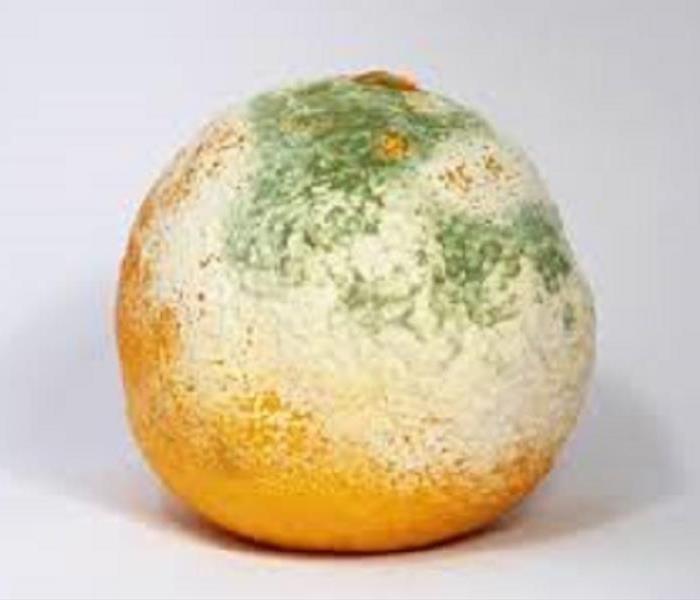 Moldy orange.
Moldy orange.
After extensive research on the subject of the different colors of mold, this topic appears to be enigmatic. Scientists have come up with several different reasons why mold comes in such an array colors but can’t seem to nail down one over the other. There is a good chance a number of things are influencing the color of any give mold.
Colors of mold for example, vary regionally. The colors in the Pacific Northwest tend to be more green and blue whereas oranges appear more often in the Amazon. Some molds secrete pigment known as melanin that can act as a barrier to protect them against other rival molds. Other studies indicate that the color of this particular fungi comes from its food source, genus, conditions under which it grows and it’s age. While all of these things do contribute in some way, shape or form, mycologists (scientists that study mold) still haven’t been able to pinpoint one single reason why this mysterious fungi comes in all colors of the rainbow to this day!






 24/7 Emergency Service
24/7 Emergency Service
